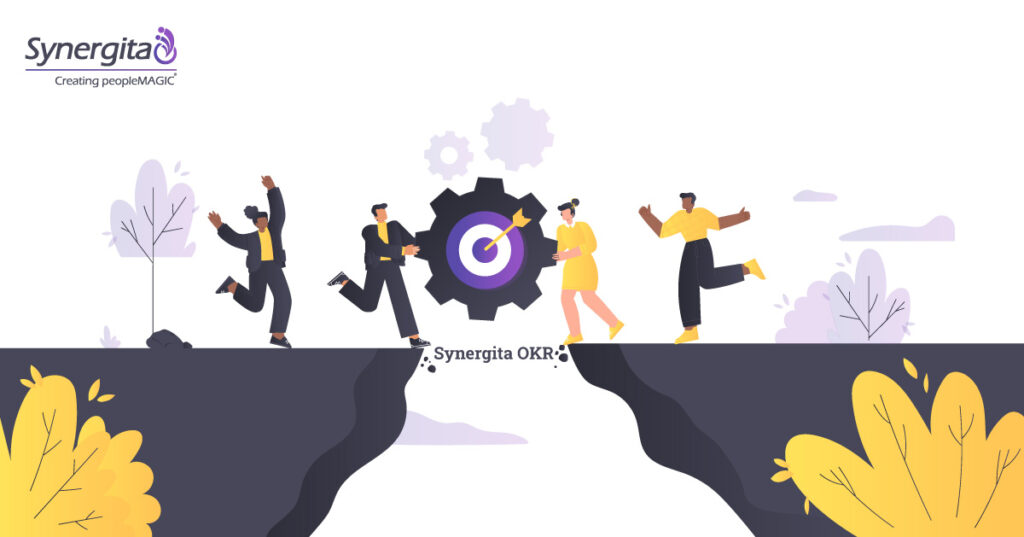Elevate Your Team’s Excellence: A Deep Dive into OKRs’ Impact
A multitude of factors determine the success of the organization. One of the most important factors that pave the way to the grandeur and success of the organization is the team. The team, often referred to as the backbone of the organization, holds the power to excel far beyond the expectations laid out by the company and its individuals. In the fast-paced and ever-evolving business landscape of today, achieving and maintaining team excellence is both a challenge and a necessity. It’s here that the concept of Objectives and Key Results (OKRs) emerges as a powerful tool to guide teams toward greatness.
This blog post is dedicated to unraveling the potential of OKRs to elevate team excellence. By delving into their implementation, impact, and real-world examples, we aim to showcase how OKRs can be harnessed as a driving force behind teams that not only meet expectations but consistently surpass them.
Understanding OKRs: Beyond Methodology, a Philosophy of Excellence
In the symphony of organizational success, the team plays a pivotal role as its heart and soul. The team’s exceptional performance and dedication are often the driving forces behind an organization’s accomplishments. In the ever-evolving landscape of modern business, achieving and maintaining team excellence isn’t just a luxury; it’s a necessity to thrive and stay ahead. This is where the concept of OKRs emerges as a powerful beacon to guide teams towards greatness.
OKRs aren’t merely a methodology; they encompass a philosophy that empowers teams to elevate their performance to new heights of excellence. Innovative minds of pioneers like Andy Grove nurtured this approach, and forward-thinking companies like Google embraced it. OKRs are more than just goal setting; they embody a structured and aspirational framework that transcends traditional paradigms.

Deconstructing the Elements: Objectives and Key Results
In the architecture of OKRs, the synergy between Objectives and Key Results forms the essence of progress. Objectives serve as guiding aspirations, igniting the team’s purpose. They transcend tasks, providing a higher sense of mission. Key Results, on the other hand, are quantifiable milestones that mark progress towards Objectives.
Objectives: Igniting Purpose
Objectives are qualitative ambitions that steer the team. They inspire and guide, offering clarity and direction. Crafted effectively, they challenge the team while remaining achievable. Objectives set the tone, shaping the team’s efforts with a shared mission.
Key Results: Milestones of Progress
Key Results are measurable checkpoints that validate advancement. They ensure accountability and offer tangible evidence of progress. Crafted SMARTly – specific, measurable, achievable, relevant, and time-bound – they enable the team to track success and adjust strategies if needed.
Synchronizing Ambition and Measurement
The strength of OKRs lies in syncing Objectives and Key Results. Objectives provide inspiration, while key results offer quantifiable benchmarks. Together, they create unity between aspiration and accomplishment. This alignment cultivates a sense of shared purpose and accountability, driving collaborative efforts towards success.
Role of OKRs in Elevating Team Excellence:
OKRs play a pivotal role in propelling teams toward exceptional performance and collective excellence. They act as navigational tools that guide teams beyond conventional boundaries, fostering collaboration, accountability, and ambition. The following points detail the role of OKRs in elevating team excellence:
Alignment for Collective Impact
OKRs unite teams around common goals, ensuring everyone moves in sync towards shared objectives. This alignment enhances coordination and maximizes the impact of collective efforts, resulting in a symphony of achievements.
Empowerment and Accountability
By setting clear Objectives and measurable Key Results, OKRs empower team members with ownership over their contributions. This instills a sense of responsibility and accountability, driving individuals to excel and contribute to team success.
Igniting Ambition
OKRs encourage teams to dream big. Ambitious Objectives push teams beyond their comfort zones, spurring innovation and creative problem-solving. This culture of aspiration fuels continuous growth and advancement.
Adaptation in a Changing Landscape
The flexibility of OKRs allows teams to adapt to changing circumstances. As market dynamics shift, teams can recalibrate their goals, enabling them to stay agile and responsive to evolving challenges and opportunities.
Motivation through Milestones
OKRs celebrate milestones of progress. As teams achieve Key Results, a sense of accomplishment boosts morale and motivation. This recognition reinforces a culture of achievement, driving teams to maintain high levels of performance.
Implementing OKRs for Team Excellence:
Implementing OKRs for achieving team excellence is a strategic process that demands thoughtful planning, seamless execution, and a commitment to fostering a culture of collaboration and achievement. The following table outlines the steps in implementing Objectives and Key Results (OKRs) for achieving team excellence, along with an example for each step:
| Steps | Description | Examples |
| Setting Clear Objectives | Craft clear and inspiring ojectives that challenge the team to stretch their capabilities while remaining achievable. | Objective: Increase Customer Retention Rate by 15% in the Next Quarter. |
| Defining Measurable Key Results | Translate objectives into measurable key results that adhere to the SMART criteria. | Objective: Increase Customer Retention Rate by 15% in the Next Quarter.Key Results: 1. Reduce the churn rate by 10%. 2. Increase the customer engagement score by 20 points. 3. Achieve a Net Promoter Score (NPS) of 9 or higher. |
| Aligning Across the Organization | Ensure alignment of objectives across teams and departments, fostering cross-functional collaboration. | All departments align their goals to contribute towards improving customer retention. Marketing focuses on enhancing customer engagement, while Customer Support aims to reduce response times. |
| Transparency and Communication | Regularly communicate Objectives and Key Results to the team, fostering a sense of ownership and collective responsibility. | Team meetings are held every week to discuss progress, challenges, and alignment towards the common Objective. |
| Cultivating Ownership and Accountability | Empower team members to take ownership of specific Key Results, enhancing accountability and commitment. | Each team member is assigned a specific Key Result to drive. For instance, one team member takes the initiative to reduce the churn rate. |
| Review and Adaptation | Regularly review progress, identify challenges, and make necessary adjustments to stay aligned with changing circumstances. | After one month, it’s evident that customer engagement is improving faster than churn reduction. The team decides to adjust efforts to further boost engagement. |
| Celebrating Achievements | Recognize milestones and accomplishments to boost morale and cultivate a culture of achievement. | At the end of the quarter, the team celebrates achieving a 12% increase in customer retention, exceeding the initial 10% target. |
Following these steps, as exemplified above, enables teams to effectively implement OKRs for team excellence. Through this strategic approach, teams can align, measure progress, adapt to changes, and celebrate achievements on the path to elevating their performance.

Impact of OKRs on Team Performance
Implementing OKRs can wield a transformative influence on team performance, revolutionizing how teams collaborate, set goals, and achieve excellence. The impact of OKRs resonates across various dimensions of team dynamics and outcomes:
1. Alignment and Clarity
OKRs serve as a guiding light, ensuring every team member comprehends the collective mission and their role in it. This alignment eliminates confusion, prevents disparate efforts, and enhances focus towards shared objectives.
2. Motivation and Ambition
Ambitious OKRs kindle a culture of aspiration within teams. The pursuit of challenging goals ignites motivation, prompting team members to go beyond their comfort zones and explore innovative solutions.
3. Accountability and Ownership
The measurable nature of key Results leaves no room for ambiguity. This clarity fosters a sense of ownership among team members, as they work diligently to achieve quantifiable milestones, contributing to overall team success.
4. Collaboration and Communication
OKRs encourage cross-functional collaboration. As teams align around common objectives, silos dissipate, and open communication flourishes. Interdisciplinary cooperation amplifies the collective impact and facilitates holistic problem-solving.
5. Adaptability and Resilience
The adaptable nature of OKRs enables teams to navigate changing circumstances with resilience. Teams can quickly recalibrate goals in response to market shifts, ensuring continuous progress even in the face of uncertainty.
6. Recognition and Morale
As teams progress towards Key Results, each achievement is celebrated. Recognition of milestones boosts morale, infusing a sense of accomplishment and reinforcing the team’s dedication to excellence.
7. Data-Driven Decision Making
OKRs hinge on measurable data. Teams rely on data-driven insights to track progress and adjust strategies. This empirical approach enhances decision-making, leading to informed choices and optimized performance.
8. Continuous Improvement
Regular reviews of OKRs cultivate a culture of continual learning and improvement. By assessing what works and what doesn’t, teams refine strategies, enhancing efficiency and fostering innovation.
9. Organizational Growth
The cumulative impact of enhanced team performance transcends individual teams, contributing to overall organizational growth. Teams that consistently excel under the OKR framework elevate the organization’s capabilities and competitiveness.
The influence of OKRs on team performance is multifaceted and profound. They serve as catalysts for alignment, motivation, accountability, collaboration, and growth, shaping teams into dynamic powerhouses that consistently strive for excellence.
Successful examples of Team excellence with OKRs
- Google: OKRs spurred innovation, aligning teams around ambitious goals for rapid growth.
- Intel: OKRs drove accountability, igniting tech advancements and industry leadership.
- LinkedIn: OKRs enhanced networking, uniting teams for user engagement and value.
- Airbnb: OKRs empower exceptional experiences, uniting teams to create global impact.
- Spotify: OKRs fueled music innovation, elevating user satisfaction and collaboration.
- Adobe: OKRs fuel the creation of quality content, fostering high performance and creativity.
- Samsung: OKRs inspired innovation, leading teams to electronics market leadership.
Common Challenges and Pitfalls in OKR Implementation
Addressing the challenges with the suggested solutions can lead to a smoother and more effective OKR implementation, fostering team excellence, and achieving desired outcomes.
| Challenges and Pitfalls | Solutions |
| Unclear Objectives | Ensure objectives are specific, measurable, achievable, relevant, and time-bound (SMART). |
| Unrealistic Goals | Balance challenge and achievability to maintain motivation and progress. |
| Misalignment | Cascade OKRs from company level down to individual teams, fostering unity. |
| Stagnant OKRs | Regularly review and adapt OKRs to stay in line with changing circumstances. |
| Leadership Buy-In | Securing endorsement from organizational leaders is pivotal as it sets the tone for commitment and fosters a culture of alignment, guiding the entire team towards a unified direction. |
| Complexity Overload | Simplify OKR structures to focus on clarity and meaningful outcomes. |
| Neglecting Feedback | Encourage open discussions and regular check-ins to assess progress. |
| Short-Term Focus | Balance OKRs with a mix of immediate goals and strategic visions. |
| Quantitative Bias | Incorporate both quantitative and qualitative key results for a comprehensive view. |
| Micromanagement | Empower teams to manage their OKRs independently while providing guidance. |
Sustaining Team Excellence with OKRs
Sustaining team excellence through OKRs requires ongoing commitment and adaptation. Regular reviews and retrospectives help teams assess progress and identify areas for improvement. As teams evolve and circumstances change, OKRs should be revised and refined to remain relevant and effective. Continuous communication, transparent reporting, and fostering a culture of learning contribute to the lasting impact of OKRs on team excellence. Teams that embrace the iterative nature of OKRs and prioritize continuous growth are better positioned to excel over the long term.
Conclusion
In conclusion, Objectives and Key Results are a dynamic framework propelling team excellence to new heights. By aligning efforts, fostering accountability, and promoting continuous improvement, OKRs empower teams to achieve remarkable results. Industry giants like Google and Airbnb showcase the transformative potential of OKRs when integrated effectively.
As the business landscape evolves, OKRs remain a reliable guide for teams navigating complexity and change. Embracing OKRs forms the basis for a future where teams consistently strive for excellence, adapt to challenges, and deliver exceptional value. Elevating team excellence through OKRs is an ongoing journey requiring dedication, collaboration, and an unwavering commitment to growth.
FAQs:
1. What are OKRs?
OKRs (Objectives and Key Results) are a goal-setting framework that helps teams define clear objectives and measurable results to achieve focused outcomes.
2. How do OKRs drive team excellence?
OKRs align teams around common goals, foster accountability, and encourage continuous improvement, driving higher levels of performance and achievement.
3. Are OKRs suitable for all types of organizations?
Yes, OKRs can be tailored to suit various organizations, industries, and team sizes, making them adaptable for diverse contexts.
4. What is the recommended review frequency for OKRs?
Regular review cycles, such as quarterly, are common for OKRs. Frequent check-ins enable teams to track progress and make necessary adjustments.
5. What happens if objectives are not achieved?
OKRs encourage learning from both successes and setbacks. Teams gain insights into what works and refine strategies for continuous improvement.
6. Can OKRs be applied to individual performance?
Yes, OKRs can be applied to individuals, aligning personal goals with team and organizational objectives, fostering collaboration and growth.
7. How can we ensure OKRs remain relevant amid changes?
Flexibility is key. Regularly revisit and adjust OKRs to adapt to evolving circumstances, ensuring they remain aligned with current goals and challenges.
Related Articles:
